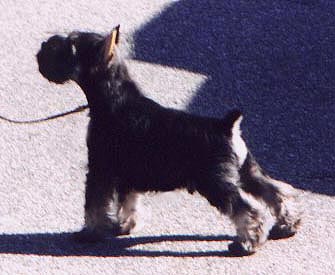|
|
Training |
I don't do any leash work with very young puppies. However, we do begin with short "duckling parades" on a quiet sidewalk. (Maximum four at a time - you might need to scramble to catch them!) They learn to follow my voice and movements while affording me a good opportunity to spot timid or independent individuals. I also take note of which puppies prefer the trot to the "bouncing ball" method of locomotion. Trotters tend to be better movers as adults.Later, leash training is done with a soft, non-slip show lead with calling, and a little tug and release when needed. I personally avoid using food when leash training. We are training dogs to look forward as they move out, not up at one's hands and face. Leading puppies around with goodies can instill awkward movement habits. Train at a distance from the house and littermates and keep the sessions short. Always end on a note of success, however small. In the beginning, let puppy trot on either side and change directions if it looks like it will help. The objective here is to encourage the puppy to trot comfortably with head and tail up - not to concentrate on where you wish him to go. Schnauzer tantrums and rodeo acts should be responded to with silence and patience until the pup settles and gives in.
Stubborn, sulky or frightened puppies need a little different approach. If the puppy seems genuinely frightened, pick him up and go do something else with him. Try another day in a different spot. Bring a happier littermate or mom to demonstrate what is requested of him. Stubborn puppies can be helped by carrying them a short distance from home and leading them back. These ones need lots of long, relaxed fun walks after they get the idea. They must look at the lead as an indication of a good time, not invitation to engage in a battle of wills.

Push him back with your knee should he crowd you or jump up. When you see a moment of success, quickly reach forward and feed him (a tiny piece) then return to your original, upright position. Leaning over puppies often intimidates them into dropping their ears and tails, or can encourage an enthusiastic one to lose patience and come forward for his food. Keep your mouth shut! Let him concentrate on the treat and just what he must do to get it to come to him. Later on, you can work on teaching him to back up - a handy trick if he starts crowding you in the ring.
Take your training and socialization to matches, and on a few short road trips to shows, when immunization is complete. Be discreet if taking puppies to shows and don't push your luck with officials by hauling around your entire half-grown kennel.
Occasionally one encounters the "natural" - a puppy seemingly born to show who learns all of the above in a matter of minutes. These are the ones we dream of, but don't blow it! Too many of these precocious ones are ruined by pushing them too hard too fast at too young an age.
DO NOT bring him to ringside too early! This is the place where where accidents happen (dog fights, spectator crowding) and where boredom is learned. 2 or 3 minutes is plenty of time to prepare for entering the ring. When you finally get him into the ring for the first time, be patient and take your time. Make sure his first experience is enjoyable and give the time he needs to get his bearings - to take in everything that is going on around him.
-Catherine McMillan
Connie Krohn with Am.Can.Ch.Minuteman No Fear - offleash, unretouched shot on Jasper Ave. in Edmonton ... the puppy at the top of the page!


